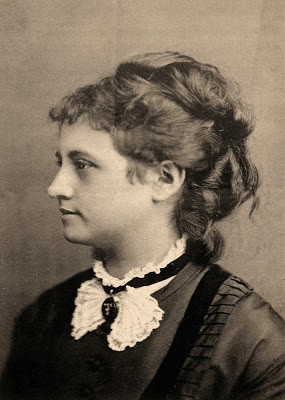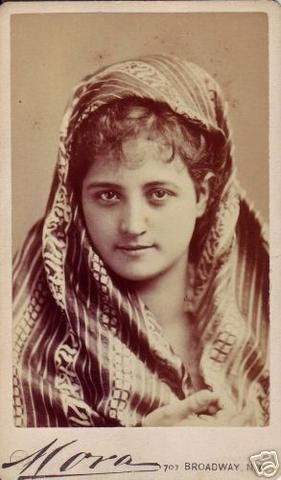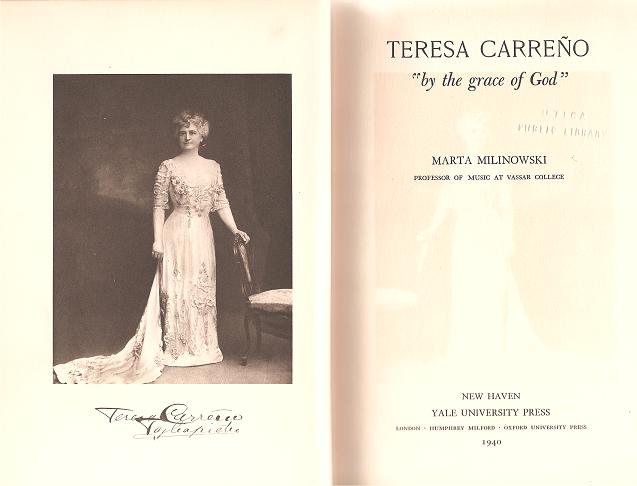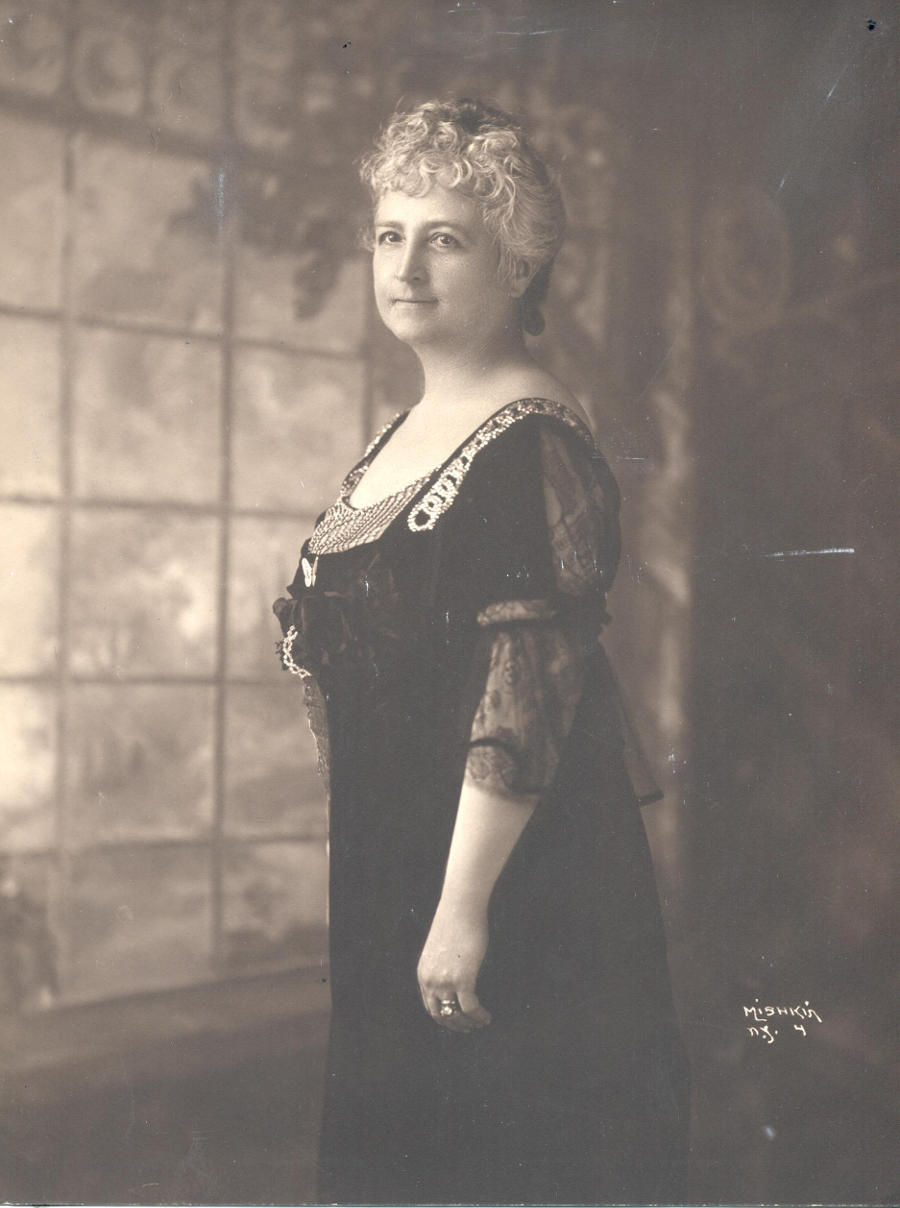The figure of Teresa Carreño has resonated worldwide since her birth in Caracas on the 22 December 1853 in the heart of a deeply musical family.

- Teresa Carreño. La Habana 1864
Teresa Carreño was one of the most accomplished pianists of the nineteenth and twentieth century, giving performances all over Europe, the United States, Cuba, Venezuela, Australasia and South Africa during a career where she gained the admiration of the most prominent musicians of her time. Gounod, Rossini, Liszt, Berlioz, Brahms, and the young pianists Claudio Arrau and Segei Rachmaninoff to name but a few, complimented her talent. She played concertos with The Berlin Philharmonic under Arthur Nikisch, August Scharrer and Hans von Bülow. Also under the baton of Gustav Mahler. She performed Grieg’s piano concerto with Grieg himself conducting and it has been reported that the composer said to her: “Madame, I did not know that my music was so beautiful”
She performed several times at the Henry Wood’s promenade concerts and an entry in his memories says about Teresa Carreño: “It is difficult to express adequately what all musicians felt about this great woman who looked like a queen among pianists – and played like a goddess. The instant she walked onto the platform her steady dignity held her audience who watched with riveted attention while she arranged the long train she habitually wore. Her masculine vigour of tone and touch and her marvelous precision on executing octave passages carried everyone completely away.”
 At a glance, during her lifetime: she composed since the age of 6 a total of 70 works for the piano, a string quartet and a Hymn to Simon Bolivar. For sometime she became a successful opera singer and conducted operas. She married, at the age of twenty, violinist Emil Sauret with whom she had a daughter, Emilita. From the age of twenty six she was in a common-law marriage with singer Giovanni Tagliapietra and had three children, just two of them survived: Teresita and Giovanni. In Berlin where she lived for thirty years she married pianist Eugene D’Albert (1892-1895) and had two more daughters, Eugenia and Hertha. In 1902 she married Arturo Tagliapetra, brother of her second husband.
At a glance, during her lifetime: she composed since the age of 6 a total of 70 works for the piano, a string quartet and a Hymn to Simon Bolivar. For sometime she became a successful opera singer and conducted operas. She married, at the age of twenty, violinist Emil Sauret with whom she had a daughter, Emilita. From the age of twenty six she was in a common-law marriage with singer Giovanni Tagliapietra and had three children, just two of them survived: Teresita and Giovanni. In Berlin where she lived for thirty years she married pianist Eugene D’Albert (1892-1895) and had two more daughters, Eugenia and Hertha. In 1902 she married Arturo Tagliapetra, brother of her second husband.
Composers Amy Beach and Edward MacDowell dedicated concertos to her, Teresa Carreño performed them as much as she could in the USA and in Europe.
When the British pianist Moura Lympany gave a recital at Carnegie Hall in 1957 (forty years after Carreño’s death) the flyer announcing her appearance contained a quote from the Los Angeles Herald & Express: “Since the days of Clara Schumann and Teresa Carreño, there have been few women pianists who could be counted among the great. Last night Moura Lympany gave evidence of possessing qualities which place her high among her historic colleagues.”
Now for this article, I would like to talk a little about her education and also about her role as a teacher since it seems to me that the legacy of great pianists is also found on their pupils, it is a way or perpetuating the art of piano playing.

Her father, Manuel Antonio Carreño, started teaching her to play the piano at the age of six, writing for her hundreds of exercises . An admirer of Teresa Carreño’s virtuosic playing, W. S. B. Mathews wrote a booklet about her: Teresa Carreño, Biographical and Critical, published in Chicago when Carreño was thirty three years old in which there is an interview where she pays tribute to her father in an attempt to contradict the myth created by the press during her time as a child prodigy. Just after her debut in the Irving Hall of New York at the age of 8, those press comments ignored this fact and stated that she could play in such an amazing way thanks to some sort of sortilege or miracle.

Teresa Carreño at the age of eight. National Portrait Gallery, Smithsonian Institution; Frederick Hill Meserve Collection.
The truth is that apart from her immense talent, her father, Manuel Antonio Carreño looked after her education until she left the parental home at the age of 18. Teresa Carreño says in said booklet the following:
“The best method (to my mind) to practice the piano has never been published (which was the one my father employed with me) To make the work quicker and easier, my father wrote five hundred exercises, which I had to do over every day for a year, comprising all the scales, arpeggios, trills, thirds, octaves, etc., etc. and difficult passages from different works of all the composers he knew (and they were quite a number!); and these I had to do every day, as I say, each day in a different key, both major and minor; and when I finished all the twenty four modes, I had to begin again, and so on until I suppose the end of my life. I had to do these running the whole length of the keyboard, in four or five different “touches,” including “staccato.” As you can imagine, when the time came to take up the “studies,” my execution had reached such a point that the controlling of the difficulties in these was a matter of comparative ease, and very quick work. To this day I begin with my practicing always by two hours of these exercises of my father’s, which of course I have to reduce to a certain limit so as to be able to do the rest of my work.”Teresa Carreño at the age of eight. National Portrait Gallery, Smithsonian Institution; Frederick Hill Meserve Collection.
Intermittently, Teresa Carreño had lessons in New York with the virtuoso and much admired pianist of the time in the Americas, Louis Moreau Gottschalk from when she was nine up to her move to Paris at the age of thirteen. In the French capital she studied with Georges Mathias, a pupil of Chopin and after a recital of hers at London’s Hanover Square Rooms in 1868, with Anton Rubinstein.
Teresa Carreño in turn was much loved as a teacher. Her pupils talk about her great generosity and warmth; one of them, Marta Milinowsky wrote her biography in 1940 “Teresa Carreño, by the grace of God” and another one, Adelaide C. Okell, wrote the preface and published in 1919 a guide that Teresa Carreño wrote on the subject of pedaling: “Possibilities of Tone Color by Artistic Use of Pedals” . In said manual Carreño explains in as much detail as possible the subtle mechanics of pedaling. According to Okell, Carreño said: “If a student does not work out the pedal effects for herself, after all I show her on the subject, she is hopeless!”
For Teresa Carreño, the tone production was the most important aspect of piano playing and to achieve it in her own words: “The great principle in piano playing, relaxation, is what I seek most indefatigably’ to inculcate in my pupils. By relaxation I do not mean flabbiness, or the tendency of some students to flop and swim all over the piano. Relaxation signifies control, and it affects the mentality of the pianist no less than his arms, wrists and fingers. I wish to make my pupils feel that piano playing is easy, not difficult; to make them regard practice as a joy, not a burden; to have them go to the piano as a painter, with a beautiful idea to express, goes to his canvas, takes up his palette and brushes and mixes his colours. But the tension under which so many players labor is dreadful. It is seen even in the muscles of the neck and face. Now this physical distress communicates itself to the intellect, so that the interpretation comes to suffer from strain. When I hear such pianists in recital I instantly feel all the discomfort they are experiencing. But too few piano students understand that relaxation is to be achieved by a mental process.”
Her famous pupil, Edward MacDowell, was about nine years old when he began to study with her. She had some anecdotes to relate of the famous composer.“His forearm was very stiff and I had no end of trouble with him,” “I used to sit at the keyboard and illustrate and then say, ‘Now, Eddie, do it just as I did.’ He would reply, ‘I can’t—that’s you—not me.’ However, the example had a good effect upon him and all through his life those who knew him realized how earnestly he worked for relaxed arms and hands.”
At the age of seventeen MacDowell sent to Teresa Carreño a roll of manuscript, accompanied by a letter in which he said: “You know, I have always had absolute confidence in your judgment. Look these over, if you will. If there is anything there any good, I will try some more, but if you think they are of no value, throw them in the paper basket and tell me, and I’ll never write another line.”
Teresa Carreño said, “I sat down and played them. There were in that bundle, the First Suite, the ‘Hexentanz,’ ‘Erzählen,’ Barcarolle and Etude de Concert. I wrote to MacDowell, ‘Throw no more into the paper basket, but keep on!’”

- Teresa Carreño in the role of Zerlina (Mozart’s Don Giovanni opera) From Frank Craven. Theatrical library
Carreño’s fulfillment as a teacher is described with the following comment as she was reading the numerous letters and messages of affection that she received from her pupils: “That, after all, is the greatest delight in a teacher’s life—or should be—this altogether maternal love which she gives her pupils and to which they respond. I have had no happiness comparable to that of beholding mine turn to me as to a mother. To fathom the student’s soul is the teacher’s highest duty.”

“One of the Greatest of All Women Pianists, Whose Death – Occurred in New York on Tuesday, June 1 2” reads the title of an article that appeared on the American press. Teresa Carreño died in her New York home in 1917. Amongst the pallbearers of her coffin were Ignace Jan Paderewski, Ernest Hutcheson, Walter Damrosch, Walter Josef Stransky, Mischa Elman, Franz Kneisel, Albert Spalding and Charles Steinway.
Louis K. Anspacher gave a memorial speech in which he mentioned the fact that she had been on stage for more than half a century and that she had played at the White House for Presidents Lincoln and Wilson also a marvelous mother and friend. “As an artist she was a master-woman, full of inspired energy and triumphant, majestic purpose. She was truly a Valkyr among pianists. Above all things, she was an initiated and a consecrated soul. “
Her ashes were later repatriated to Venezuela and are kept at the Panteón Nacional in Caracas.
There is a crater on planet Venus called Teresa Carreño.
Clara Rodriguez plays the piano music of Teresa Carreño
Clara Rodriguez plays Mi Teresita waltz by Teresa Carreño
